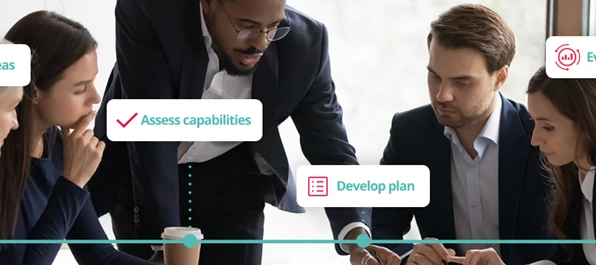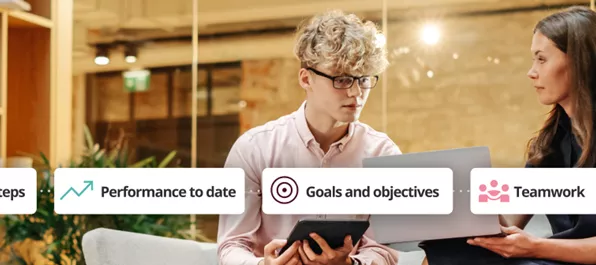-
- Employee Benefits
- Employee benefits
- Employee engagement
- Employee rewards
- Employee wellness hub
- Caboodle
-
- Your Stakeholders
- HR Director
- IT Director
- Finance Director
-
- Resources
- Guides and whitepapers
- Blogs
- Webinars
- Case studies
-
- Contact Us
- Contact Us
- Partner Programme
6 benefits of an integrated HR system
According to surveys, the average organisation now deploys more than 16 different HR systems. This number has been growing year on year, demonstrating the various priorities now sitting within the remit of HR and People managers and the requirement to digitise and automate many HR functions.
This is also reflected in the conversations we have with our own customers, who have previously been using multiple systems to manage their virtual workforce, run payroll, facilitate learning and development, support wellbeing, drive engagement, leverage reward and recognition and offer employee benefits.

What is integrated HR software?
An integrated HR system is a solution which brings together multiple HR processes into one single combined solution, reducing the need for an array of different systems trying to work together. It allows for streamlined simplicity and means that features such as payroll, recruitment , and other related HR functions will work together, with a seamless flow of data between the various tools.
The following features may also be part of an integrated HR system:
- Talent acquisition tools
- Onboarding
- Talent, appraisals and performance management
- Learning and development
- Reward and recognition
Implementing a system that factors in the importance of satisfying both organisational and individual needs with a focus on employee experience, will be the major consideration for most organisations when researching the best integrated HR systems.
The impact of multiple systems on HR functions
Customers tell us that using multiple systems can often create significant challenges and unnecessary complexity for their broader ‘HR’ functions when it comes to things like duplicate data, compliance issues and accurate reporting. This is particularly the case when systems are disconnected, and often even when point-solutions claim to be able to integrate with your other existing systems.
Adopting multiple HR systems – even those that claim to automate manual processes – usually brings with it the need for more technical expertise internally to manage and maintain the tech stack in order to get the best value out of the software. Understanding data from numerous systems often requires seasoned data professionals to interpret and analyse reports which isn’t always practical or cost-effective for organisations.
In addition, the cost implications that come with using various point-solutions means that many organisations are likely using multiple systems that have overlap in functionality, meaning that no one system is being used to its full potential and businesses are incurring considerable costs as a result.
The impact of multiple HR systems on employees
There is a common misconception that Millennial and Gen Z workers - which collectively make up the majority of the UK workforce - are all digital natives that are able to adopt new technologies quickly. In fact, with the ever-growing number of tools used by organisations, it’s likely that employees feel under-trained on their internal systems and less likely to voice their concerns.
We also hear that rather than make employees lives easier, the adoption of multiple HR systems can cause app overload and lead to workers becoming frustrated, less productive and disengaged. Without these systems being used effectively, the data gained from them becomes less valuable for leadership in making strategic decisions.
Specialised point-solutions vs an end-to-end integrated HR system
There are many benefits of 'best-in-breed’ systems that claim to have specialised or more advanced functionality than is available in an integrated system. However, relying on bespoke integrations between systems could bring potential risks of duplicate or inaccurate data. If you have particularly complex requirements that can’t be met by an integrated system, a specialised system might seem like the best option.
However, many integrated HR systems like PeopleXD now feature broader embedded functionality than typical workforce management software; with advanced recruitment and applicant tracking features, talent and performance management and reward and recognition tools. An end-to-end system doesn’t necessarily mean simplified functionality so it’s a good idea to get a personalised demo of the systems you’re shortlisting to check for yourself. We’ve found the majority of customers find that consolidating their multiple systems into one combined solution when their contracts end is preferable, whilst not compromising on the functionality they need now and in the future.
In this article we will cover the different types of integrated HR systems, the benefits to your organisation and the needs of your employees, and ultimately help you to make the best decision for your business.
See our integrated HR and Payroll system in action
Integrated HR software vs standalone HR systems
Below you can compare key features of integrated HR software alongside a standalone HR system.
Integrated HR software
Many different functions work together
Secure and unified solution
Scalable in line with business needs
Up-to-date technology offered
Standalone HR systems
Systems don’t speak to each other
Data is pulled from different sources
Difficult to add to due to compatibility of each component
May use outdated software
Whilst the above just touches upon the ways in which integrated HR software differs from standalone best-in-breed systems, there are many considerations to make when reviewing both. Find out more about standalone vs integrated HR software and decide which is right for your business.
Six benefits of integrated HR systems
Opting for a single integrated HR system can make managers' and employees' lives easier and with many knock on benefits for organisations such as increased productivity and visibility of HR metrics.
To help build your business case, this article explores the 6 key benefits of choosing an integrated HR system.
1. An integrated HR system saves time, increases visibility and reduces employee frustration
Navigating between multiple systems can be a confusing and frustrating way of working for employees, stealing valuable time and energy that could be better spent elsewhere. With built-in workflows and automation, an integrated HR system can remove many traditionally manual HR processes and as a single-sign-on solution, gives people easy access to everything they need in one place.
From an employee perspective, being able to self-serve things like their pay, annual leave, working hours, training, objectives and benefits in one place without having to log in and out of different systems can help improve job satisfaction, productivity and engagement and reduce the support needed from HR teams, in turn, saving them time too.
2. Integrated HR and payroll software reduces risk and supports data compliance
A big part of HR responsibility is ensuring that compliance is being met. However, using multiple disconnected HR systems often means having to manually input information or use additional integration tools to connect data between systems. This can be costly, time-consuming and cause issues with potential data duplication, leaving your organisation more vulnerable to the possibility of human error. Manually sharing data between systems can pose more serious risks too, including data loss, the failure to keep data securely or comply with GDPR.
An integrated HR system removes the need to create bespoke integrations between disparate systems which requires either internal resource or a vendor that will likely charge extra to support. With data kept securely in one place; the risks of human error, data loss or duplication are vastly reduced.
An integrated HR system also helps automate many aspects of compliance helping provide an audit trail of activities involving your employee’s personal data to help avoid fines if you were to be audited by the regulators. This is particularly the case with integrated HR and payroll software for example.
3. An integrated HR solution provides a single, reliable, source of truth from your data
Having to duplicate data manually across disconnected systems can inevitably lead to reduce data accuracy. With a unified and integrated HR system, data can flow freely and safely, ensuring data is consistent and only needs to be entered once.
Access to reliable data is no longer simply desirable for most organisations, particularly those with ambitious growth aims, but fundamental to support strategic decision making.
Accurate and consistent data should be the expectation from any robust HR system and a major consideration during a digital transformation project. HR departments have a valuable opportunity to uncover the insights and analytics about their workforce that can help their organisations make fundamental business decisions such as choosing where best to invest valuable time and resources to improve their employee experience.
Whilst many HR systems will be able to integrate with other best-in-breed solutions like applicant tracking systems or time and attendance software through open APIs, this is more easily and cost effectively achieved in an end-to-end solution.
4. HR integration improves reporting and decision making
Many of our customers tell us that their main reason for choosing an integrated HR system is to tackle the challenge that is reporting. Many HR teams still struggle to put together reports that show the information they need, when they need it.
Many integrated HR systems have built-in analytics and reporting tools that include both off-the-shelf and customisable reports, and dashboards that ensure HR can access their most-used reports in one place. These reports are often provided with the ability to visualise the data in a convenient way, reducing the manual input often needed with disconnected systems to export the data, add it to spreadsheets and turn into graphs and charts.
Being able to automate when reports are run also helps helps provide accurate and up-to-date data, eliminating the repetition of tasks and making reporting far easier, quicker and more reliable. This in turn frees up more HR time to spend understanding and acting on their people data, and the ability to tackle any challenges in real time.
5. HR integration streamlines talent attraction and onboarding processes
Creating a slick and efficient onboarding experience is essential when it comes to retaining top employees, and often this will require an automated and responsive system to be in place from the get go.
Research shows that more than 40% of HR managers who don’t capture onboarding information electronically spend three hours or more per employee manually collecting and processing the data. Using an integrated end-to-end system with built-in recruitment and onboarding functionality helps ensure a more streamlined transition process from initial job post, through to an applicant record seamlessly becoming a new employee, removing the need to add details manually. Having data flow throughout the employee lifecycle gives you more accurate and informative people data for making future strategic decisions, whilst also helping improve the employee experience.
6. An integrated HR system often supports single sign-on
One of the biggest benefits of an integrated solution is the ability to enable single sign-on. This helps employees find what they need quickly and easily and reduces the support time required by HR and IT. This type of HR software usually includes various access levels to ensure employees have access only to the information they need, helping support your data security too.
Is an integrated HR system right for your business?
With so many unique systems available with a variety of benefits and considerations to look at, it would seem like taking on a ‘mix and match’ approach using different standalone HR and payroll systems is the most logical way forward.
In some cases this may be true – for example, if a particular single software solution is absolutely vital to business needs, then it probably should be used even if it must sit outside of an integrated system.
However, using HR software like PeopleXD or PeopleHR, which have been built specifically to include integrated modules in one system is often a more cost effective and future proofed solution. For employee satisfaction, data reporting and HR compliance, there are huge benefits to implementing an integrated HR software system.
Integrate your HR and payroll for a reliable, end-to-end solution to workforce management
Learn more with our HR and Payroll blogs
Our HR and payroll blogs offer advice and guidance from industry experts.



